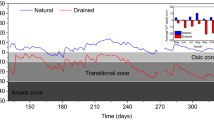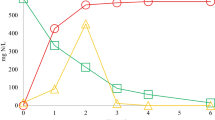Abstract
Bulbous rush (Juncus bulbosus) is a pioneer species in acidic, iron-rich, coal mining lakes in the eastern part of Germany. Juncus roots are coated with iron plaques, and it has been suggested that microbial processes under the iron plaques might be supportive for Juncus plant growth. The objectives of this work were to enumerate the microbes involved in the turnover of iron and organic root exudates in the rhizoplane, to investigate the effect of oxygen and pH on the utilization of these exudates by the rhizobacteria, and to study the ability of the root-colonizing microbiota to reduce sulfate. Enumeration studies done at pH 3 demonstrated that 106 Fe(III) reducers and 107 Fe(II) oxidizers g (fresh wt root)−1 were associated with Juncus roots. When roots were incubated in goethite-containing medium without and with supplemental glucose, Fe(II) was formed at rates approximating 1.1 mmol g (fresh wt root) −1 d−1 and 3.6 mmol g (fresh wt root)−1 d−1 under anoxic conditions, respectively. These results suggest that a rapid microbially mediated cycling of iron occurs in the rhizosphere of Juncus roots under changing redox conditions. Most-probable-number estimates of aerobes and anaerobes capable of consuming root exudates at pH 3 were similar in the rhizosphere sediment and in Juncus roots, but numbers of aerobes were significantly higher than those of anaerobes. At pH 3, supplemental organic exudates were primarily subject to aerobic oxidation to CO2 and not subject to fermentation. However, at pH 4.5, root exudates were also rapidly utilized under anoxic conditions. Root-associated sulfate reduction was not observed at pH 3 to 4.5 but was observed at pH 4.9. The pH increased during all root-incubation studies both under oxic and anoxic conditions. Thus, as result of the microbial turnover of organic root exudates, pH and CO2 levels might be elevated at the root surface and favor Juncus plants to colonize acidic habitats.



Similar content being viewed by others
References
K Alef (1991) Methodenhandbuch Bodenmikrobiologie: Aktivitäten, Biomasse, Differenzierung. Ecomed, Landsberg/Lech Germany 44–49
GD Bowen AD Rovira (1991) The rhizosphere, the hidden half of the hidden half. Y Waisel A Eishel U Kafkafi (Eds) Plants Roots—The Hidden Half. Marcel Dekker New York 641–649
TAM Bridge DB Johnson (2000) ArticleTitleReductive dissolution of ferric iron minerals by Acidiphilium SJH. Geomicrobiol J 17 193–206 Occurrence Handle10.1080/01490450050121161 Occurrence Handle1:CAS:528:DC%2BD3cXmvVelt7s%3D
A Chabbi ME Hines C Rumpel (2001) ArticleTitleThe role of organic carbon excretion by bulbous rush roots and its turnover and utilization by bacteria under iron plaques in extremely acid sediments. Environ Exper Bot 87 237–246 Occurrence Handle10.1016/S0098-8472(01)00101-0
A Chabbi W Pietsch W Wiehe RF Hüttel (1998) ArticleTitle Juncus bulbosus: Strategies of survival under extreme phytotoxic conditions in acid mine lakes in the Lusatian mining district, Germany. Int J Ecol Environ Sci 24 271–292
A Chabbi (1999) ArticleTitle Juncus bulbosus as pioneer species in acidic lignite mining lakes: interactions, mechanism and survival strategies. New Phytol 144 133–142 Occurrence Handle10.1046/j.1469-8137.1999.00503.x Occurrence Handle1:CAS:528:DyaK1MXnvVejsLc%3D
A Chabbi (2003) ArticleTitleMetal concentrations in pore water of the Lusatian lignate mining sediments and internal metal distribution in Juncus bulbosus. Wat Air Soil Pollut Focus 3 105–117 Occurrence Handle10.1023/A:1022146332223
R Chollet WL Ogren (1975) ArticleTitleRegulation of photorespiration in C3 and C4 species. Bot Rev 41 137–179 Occurrence Handle1:CAS:528:DyaE28Xos1OisA%3D%3D
RM Cornell U Schwertmann (1996) The Iron Oxides. VCH Verlagsgesellschaft mbH Weinheim 491–498
D Emerson C Moyer (1997) ArticleTitleIsolation and characterization of novel iron-oxidizing bacteria that grow at circumneutral pH. Appl Environ Microbiol 63 4784–4792 Occurrence Handle1:CAS:528:DyaK2sXnvV2rt7s%3D Occurrence Handle9406396
D Emerson JV Weiss P Megonical (1999) ArticleTitleIron-oxidizing bacteria are associated with ferric hydroxide precipitates (Fe-plaque) on the roots of wetland plants. Appl Environ Microbiol 65 2758–2761 Occurrence Handle1:CAS:528:DyaK1MXjs12gtbs%3D Occurrence Handle10347074
D Fortin B Davis TJ Beveridge (1996) ArticleTitleRole of Thiobacillus and sulfate-reducing bacteria in iron biocycling in oxic and acidic mine tailings. FEMS Microbiol Ecol 21 11–24 Occurrence Handle10.1016/0168-6496(96)00039-6 Occurrence Handle1:CAS:528:DyaK28Xlt1KitLc%3D
AJ Francis CJ Dodge JB Gillow (1992) ArticleTitleBiodegradation of metal citrate complexes and implications for toxic metal mobility. Nature 356 140–142 Occurrence Handle10.1038/356140a0 Occurrence Handle1:CAS:528:DyaK38XhvVSnsbo%3D
P Frenzel U Bosse PH Janssen (1999) ArticleTitleRice roots and methanogenesis in a paddy soil: ferric iron as an alternative electron acceptor in the rooted soil. Soil Biol Biochem 31 421–430 Occurrence Handle10.1016/S0038-0717(98)00144-8 Occurrence Handle1:CAS:528:DyaK1MXitVOqs7k%3D
SJ Grayston D Vaughan D Jones (1996) ArticleTitleRhizosphere carbon flow in trees, in comparison with annual plants: the importance of root exudation and its impact on microbial activity and nutrient availability. Appl Soil Ecol 5 29–56 Occurrence Handle10.1016/S0929-1393(96)00126-6
TA Hansen (1993) Carbon metabolism of sulfate-reducing bacteria. JM Odom R Singleton Jr (Eds) The Sulfate-Reducing Bacteria: Contemporary Perspectives. Springer Verlag New York 21–40
SF Iremonger DL Kelly (1988) ArticleTitleThe responses of four Irish wetland tree species to raised soil water levels. New Phytol 109 491–497 Occurrence Handle1:STN:280:ByyC2M%2FhvFc%3D Occurrence Handle8426929
DB Johnson (1995) Mineral cycling by microorganisms: iron bacteria. D Allsopp RR Colwell DL Hawksworth (Eds) Microbial Diversity and Ecosystem Function. CAB International, University Press, Cambridge UK 137–159
DB Johnson TAM Bridge (2002) ArticleTitleReduction of ferric iron by acidophilic heterotrophic bacteria: evidence for constitutive and inducible enzyme systems in Acidiphilium spp. J Appl Microbiol 92 315–321 Occurrence Handle10.1046/j.1365-2672.2002.01535.x Occurrence Handle1:CAS:528:DC%2BD38XhsVGktb8%3D Occurrence Handle11849360
DB Johnson S McGinness (1991) ArticleTitleFe(III) reduction by acidophilic heterotrophic bacteria. Appl Environ Microbiol 57 207–211
GM King MA Garey (1999) ArticleTitleFerric iron reduction by bacteria associated with the roots of freshwater and marine macrophytes. Appl Environ Microbiol 65 4393–4398 Occurrence Handle1:CAS:528:DyaK1MXms1OisL8%3D Occurrence Handle10508065
K Küsel T Dorsch (2000) ArticleTitleEffect of supplemental electron donors on the microbial reduction of Fe(II), sulfate, and CO2 in coal mining-impacted freshwater lake sediments. Microb Ecol 40 238–249 Occurrence Handle11080381
K Küsel T Dorsch G Acker E Stackebrandt (1999) ArticleTitleMicrobial reduction of Fe(III) in acidic sediments: Isolation of Acidiphilium cryptum JF-5 capable of coupling the reduction of Fe(III) to the oxidation of glucose. Appl Environ Microbiol 65 3633–3640 Occurrence Handle10427060
K Küsel HL Drake (1995) ArticleTitleEffects of environmental parameters on the formation and turnover of acetate by forest soils. Appl Environ Microbiol 61 3667–3675
K Küsel U Roth HL Drake (2002) ArticleTitleMicrobial reduction of Fe(III) in the presence of oxygen under low pH conditions. Environ Microbiol 4 414–421 Occurrence Handle10.1046/j.1462-2920.2002.00314.x Occurrence Handle12123477
DR Lovley EJP Phillips (1986a) ArticleTitleAvailability of Fe(III) for microbial reduction in bottom sediments of the freshwater tidal Potomac River. Appl Environ Microbiol 52 751–757 Occurrence Handle1:CAS:528:DyaL28XmtFekur4%3D
JM Lynch JM Whipps (1990) ArticleTitleSubstrate flow in the rhizosphere. Plant Soil 129 1–10 Occurrence Handle1:CAS:528:DyaK3MXotVCjtQ%3D%3D
H Marschner V Romheld I Cakman (1987) ArticleTitleRoot induced-changes of nutrient availability in the rhizosphere. J Plant Nutr 10 1175–1184 Occurrence Handle1:CAS:528:DyaL1cXhtlSntrc%3D
IA Mendelssohn BA Kleiss JS Wakeley (1995) ArticleTitleFactors controlling the formation of oxidized roots channels: A review. Wetlands 15 37–46
IA Mendelssohn MT Postek (1982) ArticleTitleElemental analysis of deposits on the roots of Spartina alterniflora loisel. Am J Bot 69 904–912
B Nixdorf M Kapfer (1998) ArticleTitleStimulation of phototrophic pelagic and benthic metabolism close to sediments in acidic mining lakes. Wat Air Soil Poll 108 317–330 Occurrence Handle10.1023/A:1005165615804 Occurrence Handle1:CAS:528:DyaK1MXjs1Whsg%3D%3D
ML Otte M Dekkers J Rozema RA Broekman (1991) ArticleTitleUptake of arsenic by Aster tripoliumi relation to rhizosphere oxidation. Can J Bot 69 2670–2677 Occurrence Handle1:CAS:528:DyaK38XisFClurk%3D
A Peine A Tritschler K Küsel S Peiffer (2000) ArticleTitleElectron flow in an iron-rich acidic sediment—evidence for an acidity-driven iron cycle. Limnol Oceanogr 45 1077–1087 Occurrence Handle1:CAS:528:DC%2BD3cXlvFCrtrg%3D
W Pietsch (1973) ArticleTitleVegetationsentwicklung und Gewässergenese in den Tagebauseen des Lausitzer Braunkohlen-Revieres. Archiv Naturschutz Landschaftsforsch 13 187–217
ER Roden RG Wetzel (1996) ArticleTitleOrganic carbon oxidation and suppression of methane production by microbial Fe(III) oxide reduction in vegetated and unvegetated freshwater wetland sediments. Limnol Oceanogr 41 1733–1748 Occurrence Handle1:CAS:528:DyaK2sXis1yisr0%3D
D Sobolev EE Roden (2001) ArticleTitleSuboxic deposition of ferric iron by bacteria in opposing gradients of Fe(II) and oxygen at circumneutral pH. Appl Environ Microbiol 67 1328–1334 Occurrence Handle10.1128/AEM.67.3.1328-1334.2001 Occurrence Handle1:CAS:528:DC%2BD3MXhslSjtr4%3D Occurrence Handle11229928
L St-Cyr AA Crowder (1989) ArticleTitleFactors affecting iron plaque on the roots of Phragmites australis (Cav.) Trin. ex Steudel. Plant Soil 116 85–93 Occurrence Handle1:CAS:528:DyaL1MXkvFKitLY%3D
L St-Cyr D Fortin PGC Campbell (1993) ArticleTitleMicroscopic observations of the iron plaque of submerged aquatic plant (Vallisneria americana Michx). Aquat Bot 46 155–167 Occurrence Handle10.1016/0304-3770(93)90043-V Occurrence Handle1:CAS:528:DyaK2cXntlCrug%3D%3D
H Tamura K Goto T Yotsuyanagi M Nagayama (1974) ArticleTitleSpectrophotometric determination of iron(II) with 1,10-phenanthroline in the presence of large amounts of iron(III). Talanta 21 314–318 Occurrence Handle10.1016/0039-9140(74)80012-3 Occurrence Handle1:CAS:528:DyaE2cXksVCqsbY%3D
NC Uren (2001) Types, amounts, and possible functions of compounds released into the rhizosphere by soil-grown plants. R Pinton Z Varanini P Nannipieri (Eds) The Rhizosphere. Marcel Dekker, Inc New York 19–40
Y Waisel M Agami (1996) Ecophysiology of roots of submerged aquatic plants. Y Waisel A Eishel U Kafkafi (Eds) Plants Roots—The Hidden Half. Marcel Dekker New York 895–909
T Wang JH Peverly (1999) ArticleTitleIron oxidation states on root surfaces of a wetland plant (Phragmites australis). Soil Sci Am J 63 247–252 Occurrence Handle1:CAS:528:DyaK1MXitFGgt7s%3D
RG Wetzel ES Brammer K Linström C Forsberg (1985) ArticleTitlePhotosynthesis of submersed macrophytes in acidified lakes. II. Carbon limitation and utilization of benthic CO2 sources. Aquat Bot 22 107–120 Occurrence Handle10.1016/0304-3770(85)90040-3
Acknowledgements
The authors express sincere appreciation to Harold L. Drake for review of the manuscript and general support of this study. Financial support was provided by the Deutsche Forschungsgemeinschaft (DFG) (Ku 1367/1-1) and the German Ministry for Education, Science, and Technology (BMBF) (PT BEO 51-0339476 C).
Author information
Authors and Affiliations
Corresponding author
Rights and permissions
About this article
Cite this article
Küsel, K., Chabbi, A. & Trinkwalter, T. Microbial Processes Associated with Roots of Bulbous Rush Coated with Iron Plaques . Microb Ecol 46, 302–311 (2003). https://doi.org/10.1007/s00248-002-1054-8
Received:
Accepted:
Published:
Issue Date:
DOI: https://doi.org/10.1007/s00248-002-1054-8




